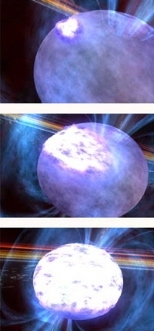Gravitational radiation -- ripples in the fabric of space predicted by Albert Einstein -- may serve as a cosmic traffic enforcer, protecting reckless pulsars from spinning too fast and blowing apart, according to a report by MIT researchers and others in the July 3 issue of Nature.
Pulsars, the fastest-spinning stars in the universe, are the core remains of exploded stars and contain the mass of our sun compressed into a sphere about 10 miles across. Some pulsars gain speed by pulling in gas from a neighboring star, reaching spin rates of nearly one revolution per millisecond, or almost 20 percent light speed. These "millisecond" pulsars would fly apart if they gained much more speed.
Using NASA's Rossi X-ray Timing Explorer, scientists have found a limit to how fast a pulsar spins and speculate that the cause is gravitational radiation --the faster a pulsar spins, the more gravitational radiation it might release, as its exquisite spherical shape becomes slightly deformed. This may restrain the pulsar's rotation and save it from obliteration.
"Nature has set a speed limit for pulsar spins," said Deepto Chakrabarty, assistant professor of physics at MIT and lead author on the Nature article. "Just like cars speeding on a highway, the fastest-spinning pulsars could technically go twice as fast, but something stops them before they break apart. It may be gravitational radiation that prevents pulsars from destroying themselves."
Chakrabarty's co-authors are research scientist Edward Morgan and postdoctoral associates Michael Muno and Duncan Galloway of MIT's Center for Space Research; Rudy Wijnands of the University of St. Andrews in Scotland; Michiel van der Klis of the University of Amsterdam; and Craig Markwardt of NASA Goddard Space Flight Center. Wijnands also leads a second Nature letter complementing this finding.
Gravitational waves, analogous to waves on an ocean, are ripples in four-dimensional spacetime. These exotic waves, predicted by Einstein's theory of relativity, are produced by massive objects in motion. They have never been directly detected, although considerable indirect evidence for them exists.
When a pulsar is created in a star explosion, it is born spinning, perhaps 30 times per second. Over millions of years, the pulsar slows down. Yet if the pulsar -- a dense star with strong gravitational attraction -- is in a binary system, then it can pull in, or accrete, material from its companion star. This influx can "spin up" the pulsar to the millisecond range, rotating hundreds of times per second.
In some pulsars, the accumulating material on the surface is occasionally consumed in a massive thermonuclear explosion that emits a burst of X-ray light lasting only a few seconds. In this fury lies a brief opportunity to measure the spin of otherwise faint pulsars. Scientists report in Nature that a type of flickering found in these X-ray bursts, called "burst oscillations," serves as a direct measure of the pulsar's spin rate. Studying the burst oscillations from 11 pulsars, they found none spinning faster than 619 times per second.
The Rossi Explorer is capable of detecting pulsars spinning as fast as 4,000 times per second. Pulsar breakup is predicted to occur at 1,000 to 3,000 revolutions per second. Yet scientists have found none that fast. From a statistical analysis of 11 pulsars, they concluded that the maximum speed seen in nature must be below 760 revolutions per second, too slow for pulsar breakup to occur.
This observation supports the theory of a feedback mechanism involving gravitational radiation that limits pulsar speeds, proposed by Lars Bildsten of the Kavli Institute of Theoretical Physics at the University of California at Santa Barbara. As the pulsar picks up speed through accretion, any slight distortion in the star's dense, half-mile-thick crust of crystalline metal will allow the pulsar to radiate gravitational waves. (Envision a spinning oblong rugby ball in water, which would cause more ripples than a spinning spherical basketball.) An equilibrium rotation rate is eventually reached where the angular momentum shed by emitting gravitational radiation matches the angular momentum being added to the star by the rotating material flowing onto its surface.
Bildsten said that accreting millisecond pulsars could eventually be studied in greater detail in an entirely new way, through the direct detection of their gravitational radiation. LIGO, the Laser Interferometer Gravitational-Wave Observatory now in operation in Hanford, Wash., and Livingston, La., will eventually be tunable to the frequency at which millisecond pulsars are expected to emit gravitational waves.
"The waves are subtle, altering spacetime and the distance between objects as far apart as the earth and the moon by much less than the width of an atom," said Barry Barish of the California Institute of Technology, the LIGO director. "As such, gravitational radiation has not been directly detected yet. We hope to change that soon."






